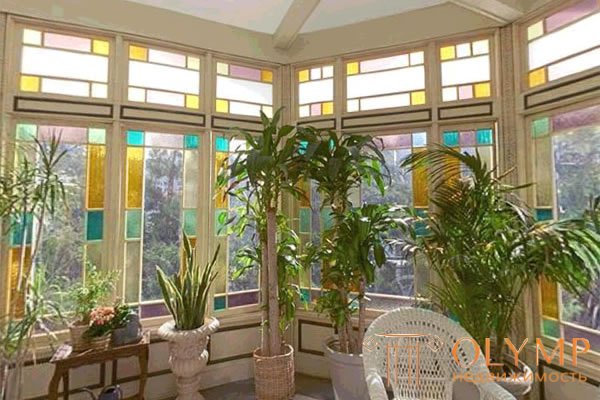
Mini-greenhouses can be arranged on the veranda, loggia, balcony. Of course, these premises must meet certain requirements. First, they should be spacious enough. If you plant a small balcony, there may not be a place for rest. But the main purpose of the mini-greenhouse is to create the necessary conditions for rest, stress relief, and even stress. In addition, the room should be heated in winter. This involves the installation of electric heater, and best of all - the installation of water heating. Will require the installation of a ventilation system, air conditioning. It is not always possible in the winter to just ventilate the room. The cold winter air will simply kill the plants or provoke various diseases.

The second - the glazing of the veranda, loggia, balcony, will need to be double, triple, always warmed. Without this, no heating or air conditioning will help.
To begin with, what could be the heating system in the mentioned mini-greenhouses. In addition to water and electric heating can be: air, steam, furnace. Oven we will not consider now, we will mention only one of the options for such heating. We are talking about a country house that does not have central heating, and electric fireplaces cannot solve the problem of heating the whole house. In this case, the best stove heating. Here, the method of forcing a portion of heat from the furnace is used to heat the mini-greenhouse. The design is a film sleeve of the required length, which at one end has slit cuts through which air enters the mini-greenhouse. At the other end of this sleeve is a small fan that supplies warm air to the sleeve. The ideal solution would be to use for pumping air ordinary old vacuum cleaner. But this method of heating has a significant drawback - significant differences in air temperature: high temperature during furnace heating and low in the intervals between furnaces.
Water heating is the best option for mini-greenhouses. Heat is evenly distributed throughout the room, gradually leveling the air temperature. Installing batteries along the glazing, being the traditional way of installing water heating in general, provides the most favorable temperature conditions. And if you also use a heat distribution screen in the form of a curtain of polyethylene film, you can adjust the heat for individual groups of plants within the same greenhouse. Air heating can be used under the conditions of the presence of an adjacent stable heated room. For example, in an adjacent room a stable temperature is maintained due to water (steam) heating. The premises of the mini-greenhouse (veranda, loggia, balcony) are sufficiently insulated, have double glazing, i.e. able to keep the heat received from the outside. In the presence of these conditions, it remains only to purchase in the distribution network a special design of a mini-fan, allowing its installation in a window in any other opening made for this purpose in the partition between the room and the veranda (loggia, balcony). The disadvantage of such heating is that it will be almost impossible to regulate the temperature in the mini-greenhouse, it will always be lower than the temperature in the heated room. And in the event of a temperature drop in the water heating system, the temperature in the mini-greenhouse may drop to unacceptably low values. Heating with electrofireplaces is just as effective as with water (steam) heating, but it’s quite a wasteful way of obtaining heat. "Moreover, not all electric heaters are suitable for this purpose. Some of them are detrimental to vegetation. Therefore, this kind of heating in case of inability to use other heat sources.
Steam heating is characterized by stable temperature conditions favorable for plants (as well as water). However, at night to reduce the air temperature the room must be ventilated. Now we will move on from the problem of heating to the equally important issue of insulating the walls and window openings of the veranda, and in the case of a loggia and balcony - to the glazing of the latter while enhancing the thermal protection of the installed structures. Let's start with the insulation of walls and concrete fences of loggias and balconies. It will be a question of application of heaters. Best of all, light mineral and organic materials with a bulk mass of up to 500 kg / m3 are suitable for this purpose. Mineral wool boards - the most effective insulation. They are light, fire-resistant, do not rot, are not destroyed by rodents. Other mineral insulants are significantly inferior to mineral wool in thermal conductivity and their use in areas with an estimated outdoor temperature below -25 ° C is impractical. In addition, the bulk materials during operation can give a draft and form voids. Polystyrene is flammable and in most cases has relatively high toxicity.
Thermal insulation of the walls of the veranda and concrete fencing of the balconies is carried out by creating additional inner lining, providing for the presence of voids to accommodate plates of insulation (bulk insulation). Any insulation used should be well dried. To determine the coefficient of thermal conductivity of the materials used is quite simple: the lighter the material; the better its thermal protection. If the material used has high humidity, the space between the wall and the inner lining will dampen and it will be very difficult, if not impossible, to deal with it later. All insulating materials are very poor in moisture, this is their peculiarity. When using organic insulating materials, they must be antiseptic. Otherwise, there is a danger of their rotting, the consequences of which are obvious. If loose insulators are used, it should be taken into account that over time they become compacted and form voids. And the presence of voids leads to deterioration of the insulating properties of the partition. To avoid this, it is necessary in the upper parts of the casing design to provide removable panels for additional backfill sealing insulation.
Что бы оставить комментарий войдите
Комментарии (0)